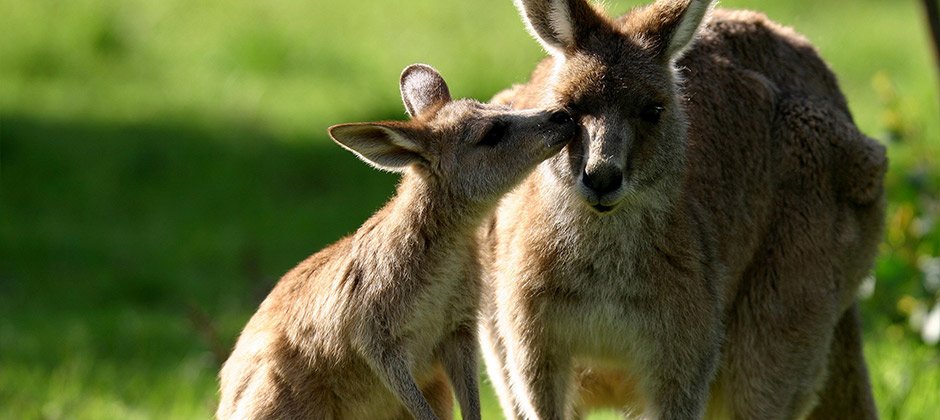

EACH NIGHT IN REMOTE AREAS OF THE AUSTRALIAN OUTBACK, THOUSANDS OF KANGAROOS GRAZE PEACEFULLY, STAND UP ON HEARING AN APPROACHING VEHICLE, STARE INTO A BLINDING SPOTLIGHT, AND ARE SHOT FOR THEIR FLESH AND SKINS.
HIDDEN CRUELTY
Due to the remote locations where the commercial kangaroo shoot takes place there is no effective monitoring of animal welfare. No statistics are available for the animals who are wounded and escape, only to endure a long and painful death. The kangaroo industry Code of Practice requires that animals are killed by a single shot to the head, but even conservative estimates suggest that more than tens of thousands of the adult kangaroos commercially ‘processed’ each year are not killed in this manner.
Once again we have a cruel animal industry that continues only because it can operate without public scrutiny. Tonight, while you are sleeping peacefully, out in the Australian bush the peaceful existence of thousands of gentle animals who have harmed no-one will end violently — for the sake of the mighty dollar.
A COMMERCIAL SLAUGHTER
Don’t be fooled by protests that kangaroos are shot because they compete with grazing animals — this mass slaughter is purely and simply a commercial kill of Australian wildlife. In 2016, 1.34 million kangaroos were killed for the commercial industry. Some skins and meat products are used domestically (a proportion of kangaroo meat goes into the Australian pet food market), and the rest is exported to other countries (two thirds to Europe) as leather or meat for human consumption. Kangaroo leather is widely used in the manufacture of sporting shoes and gloves as well as in dress shoes and accessory manufacture.
ORPHANED JOEYS
The fate of orphaned young, too small to be of any commercial value to hunters, is grim. ‘In pouch’ joeys of shot mothers are either decapitated (if very small) or killed with a blow to the head. Dependent ‘at foot’ joeys often escape, and suddenly face a life alone, often falling victim to predators, exposure or starvation. The mother and joey bond is immensely strong. Red kangaroos are not weaned until a year after birth and Eastern and Western Grey Kangaroos are not weaned until they are nearly 18 months old.
A two-year investigation — conducted by the Wildlife Protection Association of Australia (WPAA) and Animal Liberation NSW, and based on information provided by a kangaroo industry ‘whistleblower’ — found evidence of unsustainable and damning practices in the kangaroo industry. Some 24 chillers (holding facilities for carcasses) around NSW and Southern QLD were inspected and samples from carcasses taken for testing. This investigation revealed that:
- A large proportion (70-80%) of stored carcasses were non-preferred female kangaroos, indicating a likely current population imbalance, and indicating that there are only low numbers of (the larger preferred) males available to shoot. This is of great concern as these strong adult males are needed to maintain an ongoing healthy gene pool.
- Many of the carcasses were barely above the (NSW) minimum permitted ‘human consumption’ weight of 13kg, and those females were unlikely to have even had a single joey — revealing once again an absence from the population of the larger adult kangaroos.
- Carcasses swabbed by investigators were contaminated by dangerous bacteria, including E.coli, Streptococcus and Staphylococcus.
GRUBBY REALITY EXPOSED
A Shot in the Dark — a report on kangaroo harvesting, a 2009 report commissioned by Animal Liberation (NSW), outlines problems of hygiene in the kangaroo meat industry, sustainability of kangaroo populations and animal welfare. The report estimates some ‘440,000 dependent young kangaroos are either clubbed to death or justify to starve after their mothers are killed’. The full report, prepared by wildlife ecologist Dr Dror Ben-Ami, also includes material on contamination of kangaroo meat and sustainability issues.
And, as highlighted in the acclaimed documentary film ‘Kangaroo: A Love-Hate Story’, scientists warn that estimates of kangaroo numbers in Australia are way off-target, with faulty counting methods hugely inflating the estimated national population of kangaroos. If kangaroos continue to be shot, injured and killed at the current rate allowed by the Australian government, with the added risk of persistent drought and climate change, we may face a future where this iconic native animal is nothing but a memory.



